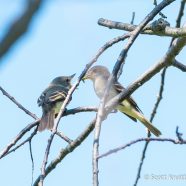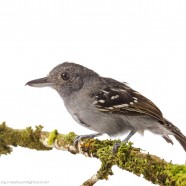Fledgling Flycatcher
While some Willow Flycatchers (Empidonax traillii) are on the way south, like the bird I posted from last Friday evening, others are still finishing up raising the next generation. I photographed this cute family moment this past weekend while they kept their distance from me – please ignore the annoying branches obscuring the scene. I was happy enough to see that they had not fallen victim to a Brown-headed Cowbird. Good thing there are enough caterpillars to go around…any for me? Scott Kruitbosch Conservation & Outreach Coordinator
Read MoreMockingbird Parent
The Northern Mockingbird (Mimus polyglottos) seen here was as ferocious as a dinosa — er, bird, can get. Well, maybe not in the literal sense, but did you ever have the feeling that something was out to get you? This bird felt like giving me a tap or two in the head, something Mockingbirds did to me as a child on multiple occasions while on our patio near a nest in a bush. It turns out that the nasty look I was receiving here was for a similar reason as there were fledglings nearby. This Mockingbird refused to fly away as I walked up the roadway within several feet and stared me down...
Read MoreKilldeer
I finally got around to editing these photos of a Killdeer (Charadrius vociferus) taken during the Noble Proctor BioBlitz Challenge last month. The bird appeared in the first photo like any other – no big deal. Oh no, this bird is “injured”! Not so much. This is a distraction display, feigning injury, in order to draw our group away from the area and protect a nest or young hatchlings. The bird makes it look like it has a broken wing and has lost the ability to fly, attempting to tempt mammals like us into running them down for a meal (before they fly away). If we did then...
Read MoreYoung Northern Mockingbird
This fledgling/juvenile Northern Mockingbird (Mimus polyglottos) is described as such by me because it certainly looks and acts old enough to get its own food, but it keeps on begging for a delivery. One of the parents flew in and fed it a snack a moment later. It’s September, and it is time to get going, young one! The days keep getting shorter and soon enough you will be having to find your own meals. Scott Kruitbosch Conservation & Outreach Coordinator
Read MoreWestern Slaty-Antshrike (Thamnophilus atrinucha)
According to Sean, the Western Slaty-Antshrike (Thamnophilus atrinucha) is one of the most well studied birds in Panama, due to their inquisitive nature and temperamental attitudes. A male and female usually form a tight bond and forage together. Sometimes they will join up with other antbirds in feeding flocks. They can be found in a wide variety of secondary and primary forest habitat types. They also have one of the most dynamic breeding seasons as it can last the entire year with small clutch sizes, extended post-fledging parental care, and delayed dispersal. Photographed by RTPI...
Read More








